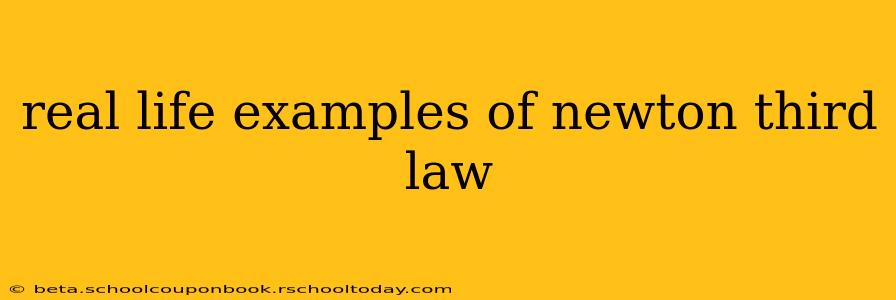Newton's Third Law of Motion, often simplified as "for every action, there's an equal and opposite reaction," governs countless interactions in our everyday lives. Understanding this law goes beyond rote memorization; it's key to grasping how forces shape our world. Let's explore some compelling real-life examples, moving from the simple to more complex scenarios.
Everyday Demonstrations of Action-Reaction Pairs
Many everyday actions showcase Newton's Third Law in a straightforward manner:
-
Walking: When you walk, you push backward on the ground (action). The ground, in turn, pushes you forward with an equal and opposite force (reaction), propelling you ahead. Without this reaction force, you wouldn't be able to move.
-
Swimming: Swimmers propel themselves through the water by pushing backward against it (action). The water simultaneously exerts an equal and opposite force forward, moving the swimmer.
-
Jumping: To jump, you push down on the Earth (action). The Earth simultaneously pushes back up on you with an equal and opposite force (reaction), launching you into the air. Notice that the Earth also moves slightly as a consequence, though imperceptibly due to its immense mass.
-
Rocket Propulsion: Rockets work on the principle of Newton's Third Law. They expel hot gases downward (action), and the gases exert an equal and opposite upward force on the rocket (reaction), causing it to accelerate.
-
Rowing a Boat: Rowers pull on their oars (action), pushing the water backward. The water resists this push, creating an equal and opposite force pushing the boat forward (reaction).
More Subtle Applications of Newton's Third Law
Some applications of Newton's Third Law are less obvious but equally important:
-
Birds in Flight: Birds use their wings to push air downwards (action). The air pushes back upwards on their wings (reaction), providing lift and enabling flight. This is a complex interaction involving many factors, but Newton's Third Law is fundamental.
-
Balloons: When you inflate a balloon and release it, the air rushes out of the opening (action). This escaping air exerts a force on the balloon in the opposite direction, propelling it forward (reaction).
-
Car Acceleration: A car's engine drives the wheels, which push backward on the road surface (action). The road, in turn, exerts an equal and opposite forward force on the car's tires (reaction), causing it to accelerate. This explains why cars struggle to accelerate on slippery surfaces—the reaction force is reduced due to lack of friction.
Misconceptions and Clarifications
A common misunderstanding is that the action and reaction forces cancel each other out. They do not cancel each other out because they act on different objects. The action force acts on one object, while the reaction force acts on a different object. This is crucial to understanding how motion occurs.
Conclusion
Newton's Third Law is a cornerstone of classical mechanics, influencing everything from our everyday movements to the propulsion of rockets. By understanding action-reaction pairs, we gain a deeper appreciation of the forces shaping our world and the intricate dance of physics in motion. The examples discussed here are merely a starting point for exploring the profound implications of this fundamental law. Further investigation into specific applications will reveal even more fascinating examples.
